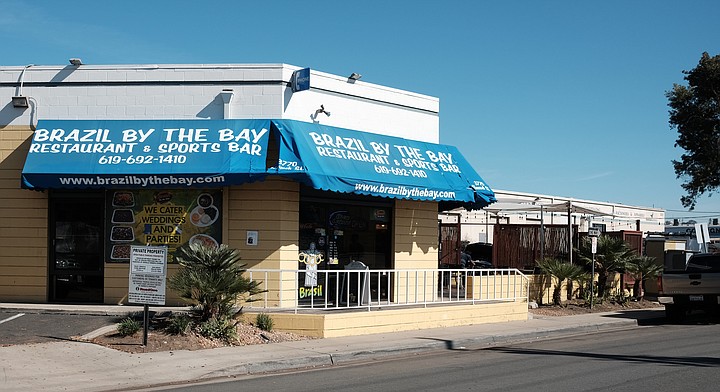 Facebook
Facebook
 X
X
 Instagram
Instagram
 TikTok
TikTok
 Youtube
Youtube

If you've ever driven up Hancock Street where the 8 meets the 5 in the northeast corner of Point Loma, you know that the one-way stretch slowly loops through an old industrial area that wouldn't be of much use to anyone who hasn't had their car towed, except that there are a growing number of beer and coffee businesses back there. Also back there is one of the city's least likely restaurant locations.

Brazil by the Bay is technically by Mission Bay as the crow flies, but all I could see through the casual eatery's windows was the backside of the Sports Arena. A banner strung across the old venue informed me that San Diego has a hockey team. Go Gulls, I guess. Just don't ask for a new stadium.
I've eaten enough Brazilian food to know that I enjoy it, but not enough to learn the lingo. "What's farofa?" I had to ask my waitress. Turns out it's the accurate term for toasted yucca flour, which is actually one of the unlikely reasons I'm fond of Brazilian cuisine.
There's barely anything to farofa — it doesn't really even rate as a side dish. It's essentially a dry condiment, resembling a pile of bread crumbs, and often similarly seasoned. But when you mix it with your side of rice and beans, it gives them a pleasing, gritty, crunchy texture. Same with meats.
Yes, churrasco grilled meats top the list of reasons to dine Brazilian, so as I perused the menu's Prato Feito options (that loosely translates to combo plate), I found myself choosing between beef, chicken, fish, and calabresa — the Brazilian take on Portuguese linguiça sausage (each ranged between 12 and 14 bucks).
I chose the latter, served acebolado (with onions). I'd barely been there five minutes and already this place was improving my understanding of Portuguese. All of the other patrons spoke it to the restaurant staff, with some familiarity. I take that as a good sign — if the place has Brazilian regulars, it must be doing something right.
The finely minced sausage was served sliced, with caramelized onions, so as I started mixing up my plate's red beans, rice, and farofa, it seemed easier to mix the sausage and onions together as well. That yucca flour crunch, it works just as well to dress meat.
The waitress brought one last element to tie the dish together: malagueta chile sauce. That's another Brazilian mainstay, made with the high scoville malagueta pepper. Its bright, fruity spice has some real kick, and even with the lightest splash I could feel some burn.
My prato tasted just fine without it (nothing earth-shaking) but adding the spice gave my dish that touch of exotic flavor that makes eating another culture's food so worthwhile. Brazil by the Bay also features a small Brazilian market where you may buy farofa, calabresa, malagueta, and other South American specialties.


If you've ever driven up Hancock Street where the 8 meets the 5 in the northeast corner of Point Loma, you know that the one-way stretch slowly loops through an old industrial area that wouldn't be of much use to anyone who hasn't had their car towed, except that there are a growing number of beer and coffee businesses back there. Also back there is one of the city's least likely restaurant locations.

Brazil by the Bay is technically by Mission Bay as the crow flies, but all I could see through the casual eatery's windows was the backside of the Sports Arena. A banner strung across the old venue informed me that San Diego has a hockey team. Go Gulls, I guess. Just don't ask for a new stadium.
I've eaten enough Brazilian food to know that I enjoy it, but not enough to learn the lingo. "What's farofa?" I had to ask my waitress. Turns out it's the accurate term for toasted yucca flour, which is actually one of the unlikely reasons I'm fond of Brazilian cuisine.
There's barely anything to farofa — it doesn't really even rate as a side dish. It's essentially a dry condiment, resembling a pile of bread crumbs, and often similarly seasoned. But when you mix it with your side of rice and beans, it gives them a pleasing, gritty, crunchy texture. Same with meats.
Yes, churrasco grilled meats top the list of reasons to dine Brazilian, so as I perused the menu's Prato Feito options (that loosely translates to combo plate), I found myself choosing between beef, chicken, fish, and calabresa — the Brazilian take on Portuguese linguiça sausage (each ranged between 12 and 14 bucks).
I chose the latter, served acebolado (with onions). I'd barely been there five minutes and already this place was improving my understanding of Portuguese. All of the other patrons spoke it to the restaurant staff, with some familiarity. I take that as a good sign — if the place has Brazilian regulars, it must be doing something right.
The finely minced sausage was served sliced, with caramelized onions, so as I started mixing up my plate's red beans, rice, and farofa, it seemed easier to mix the sausage and onions together as well. That yucca flour crunch, it works just as well to dress meat.
The waitress brought one last element to tie the dish together: malagueta chile sauce. That's another Brazilian mainstay, made with the high scoville malagueta pepper. Its bright, fruity spice has some real kick, and even with the lightest splash I could feel some burn.
My prato tasted just fine without it (nothing earth-shaking) but adding the spice gave my dish that touch of exotic flavor that makes eating another culture's food so worthwhile. Brazil by the Bay also features a small Brazilian market where you may buy farofa, calabresa, malagueta, and other South American specialties.
Comments